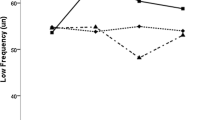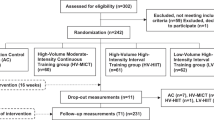Abstract
Background
The acute hypotensive effect after a physical exercise session can be a valuable tool for reducing long-term cardiovascular risk.
Aim
To evaluate blood pressure and heart rate variability (HRV) pre/post a single Brazilian Jiu-Jitsu (BJJ) training session.
Methods
Eighteen athletes were selected, (age 31 ± 10; BMI 25.9 ± 2.5), from higher to lower rank and collected/analyzed pre/post HRV in the domain of time, of frequency and of non-linear indices. The statistic included the Kolmogorov–Smirnov test, Levene test, and ANOVA of two inputs with post hoc by Holm Sidak. In addition, the unpaired t-Student;s test and the Mann–Whitney test were applied. The level of significance was p < 0.05 and the analyses were performed using SigmaPlot for Windows version 11.0 software.
Results
The HRV in the time and frequency domain showed significant differences in most of the analyzed variables. Furthermore, the SD1 indices, which reflect the total variability, as well as the SD2 which reflects the parasympathetic modulation, showed a difference in the less graduated (p < 0.020; p < 0.030) and the most highly graduated athletes (p < 0.001; p < 0.013), respectively. The systolic blood pressure had a significant reduction in both groups, composed of less graduated athletes (p < 0.013), as well as, in the more graduated ones (p < 0.028), suggesting a hypotensive effect, due to the possible action of the physiological vasodilator mechanisms.
Conclusion
The findings of the present study suggest that a single JJ training session can reduce pressure values in athletes of this modality, even with the HRV parameters showing greater sympathetic modulation compared to pre-intervention values.





Similar content being viewed by others
Data availability
No data is available besides the published
Abbreviations
- SBP:
-
Systolic blood pressure
- DBP:
-
Diastolic blood pressure
- PEH:
-
Post-exercise hypotension
- BP:
-
Blood pressure
- HRV:
-
Heart rate variability
- BJJ:
-
Brazilian jiu-jitsu
- CBJJ:
-
Brazilian Jiu-Jitsu Confederation
- HRV:
-
Heart rate variability
- ICF:
-
Informed consent form
References
Wegmann M et al (2018) Postexercise hypotension as a predictor for long-term training-induced blood pressure reduction: a large-scale randomized controlled trial. Clin J Sports Med 28(6):509–515. https://doi.org/10.1097/JSM.0000000000000475
Figueiredo T, De Salles BF, Dias I, Reis VM, Fleck SJ, Simão R (2014) Acute hypotensive effects after a strength training session: a review. Int Sportmed J. 15(3):308–329
Caminiti G, Mancuso A, Raposo AF, Fossati C, Selli S, Volterrani M (2019) Different exercise modalities exert opposite acute effects on short-term blood pressure variability in male patients with hypertension. Eur J Prev Cardiol 26(10):1028–1031. https://doi.org/10.1177/2047487318819529
Júnior FA, Gomes SG, da Silva FF (2019) The effects of aquatic and land exercise on resting blood pressure and post-exercise hypotension response in elderly hypertensives. Cardiovasc J Afr 25(30):1–7. https://doi.org/10.5830/CVJA-2019-051
Machado CLF, Bgeginski R, De Castro C, Wilhelm EN, Pinto RS (2019) Acute hemodynamic responses to repetitions to failure using different resistance exercises and protocols in normotensive men: a crossover study. Clin Exp Hypertens 8:1–8. https://doi.org/10.1080/10641963.2019.1676772
Domingos E, Polito MD (2018) Blood pressure response between resistance exercise with and without blood flow restriction: a systematic review and meta-analysis. Life Sci 15(209):122–131. https://doi.org/10.1016/j.lfs.2018.08.006
Silva TFD et al (2017) Effect of the exercise of walkers performed in public squares with spontaneous or prescribed intensity on post-exercise hypotension. Rev Saude Publica 51(71):1–10. https://doi.org/10.1590/S1518-8787.2017051006247
Oliveira R, Barker AR, Debras F, O’Doherty A, Williams CA (2018) Mechanisms of blood pressure control following acute exercise in adolescents: effects of exercise intensity on hemodynamics and baroreflex sensitivity. Exp Physiol 103(8):1056–1066. https://doi.org/10.1113/EP086999
Ferrari et al (2017) Effects of concurrent and aerobic exercises on postexercise hypotension in elderly hypertensive men. Exp Gerontol 98:1–7. https://doi.org/10.1016/j.exger.2017.08.012
Lemos S et al (2018) Effects of strength training sessions performed with different exercise orders and intervals on blood pressure and heart rate variability. Int J Exerc Sci 11(2):55–67
Rezende RA, Santos DA, Junior ND, Forjaz CL, Tinucci C (2013) Fase do treinamento esportivo não afeta a variabilidade da frequência cardíaca em atletas de jiu-jitsu. Rev Soc Cardiol Estado de São Paulo 23(3):21–25
Williamson JW (2010) The relevance of central command for the neural cardiovascular control of exercise. Exp Phsiol 95(11):1043–1048. https://doi.org/10.1113/expphysiol.2009.051870
Persson PB (2015) The multiple functions of the endothelium: more than just wallpaper. Acta Physiol 4(213):747–749. https://doi.org/10.1111/apha.12464
Cardozo DC et al (2019) The effect of exercise order in circuit training on muscular strength and functional fitness in older women. Int J Exerc Sci 12(4):657–665
Mannarino P, Matta T, Lima J, Simão R, Freitas de Salles B (2019) Single-joint exercise results in higher hypertrophy of elbow flexors than multijoint exercise. J Strength Cond Res. https://doi.org/10.1519/JSC.0000000000003234
Schwartz J, Takito MY, Del Vecchio FB et al (2015) Health-related physical fitness in martial arts and combat sports practitioners. Sport Sci Health 11(2):171–180. https://doi.org/10.1007/s11332-015-0220-6
Malik M (1996) Taskforce of the European society of cardiology and the North American society of pacing and electrophysiology. Heart rate variability. Standards of measurement, physiological interpretation, and clinical use. Eur Heart J 17:354–381
Farinatti P, Cordeiro R, Vogel M, Machado S, Monteiro W (2019) Postexercise blood pressure and autonomic responses after aerobic exercise following anodal tDCS applied over the medial prefrontal córtex. Neurosci Lett 21(7):11–134444. https://doi.org/10.1016/j.neulet.2019.134444
Cunha FA, Midgley AW, Soares PP, Farinatti P (2015) Postexercise hypotension after maximal short-term incremental exercise depends on exercise modality. Appl Physiol Nutr Metab 40(6):605–614. https://doi.org/10.1139/apnm-2014-0354
Mota MR, de Oliveira RJ, Dutra MT, Pardono E, Terra DF, Lima RM et al (2013) Acute and chronic effects of resistive exercise on blood pressure in hypertensive elderly women. J Strength Cond Res 27:3475–3480. https://doi.org/10.1519/JSC.0b013e31828f2766
Nasser I, Willardson J, Mello PR, Reis MS, Brito A, Dias IF et al (2019) Effect of different circuit training on cardiovascular responses in cirrhotic patients. Int J Sports Med 40(2):139–146. https://doi.org/10.1055/a-0783-2747
Henríquez OC, Báez SM, Von Oetinger A, Cañas JR, Ramírez CR (2013) Autonomic control of heart rate after exercise in trained wrestlers. Biol Sport 30(2):111–115. https://doi.org/10.5604/20831862.1044429
Kraemer WJ, Ratamess NA (2005) Hormonal responses and adaptations to resistance exercise and training. Sports Med 35(4):339–361. https://doi.org/10.2165/00007256-200535040-00004
Durand MJ, Gutterman DD (2014) Exercise and vascular function: How much is too much? Can J Physiol Pharmacol 92(7):551–557. https://doi.org/10.1139/cjpp-2013-0486
Sang WJ, Sun HK, Si HK, Hee JK, Chang HY, Tae JY et al (2019) Mortality reduction with physical activity in patients with and without cardiovascular disease. Eur Heart J. https://doi.org/10.1093/eurheartj/ehz564
Brito AF, de Oliveira CVC, Brasileiro-Santos MD, da Nóbrega TKS, Forjaz CLM, Santos AC (2015) High-intensity resistance training promotes post-exercise hypotension greater than moderate intensity and affects cardiac autonomic responses in hypertensive women. J Strength Cond Res 29:3486–3493. https://doi.org/10.1519/JSC.0000000000001009
Figueiredo T, Willardson JM, Miranda H, Bentes CM, Reis VM, Simão R (2015) Influence of load intensity on postexercise hypotension and heart rate variability after a strength training session. J Strength Cond Res 29:2941–2948. https://doi.org/10.1519/JSC.0000000000000954
Figueiredo T, Willardson JM, Miranda H, Bentes CM, Reis VM, De Salles BF et al (2016) Influence of rest interval length between sets on blood pressure and heart rate variability after a strength training session performed by prehypertensive men. J Strength Cond Res 30:1813–1824. https://doi.org/10.1519/JSC.0000000000001302
Figueiredo T, Menezes P, Kattenbraker MS, Polito MD, Reis VM, Simão R (2013) Influence of exercise order on blood pressure and heart rate variability after a strength training session. J Sports Med Phys Fitness 53:12–17
Andreato LV, Julio UF, Panissa VL, Esteves JV, Hardt F, de Moraes SM et al (2015) Brazilian jiu-jitsu simulated competition part i: metabolic, hormonal, cellular damage, and heart rate responses. J Strength Cond Res 29(9):2538–2549. https://doi.org/10.1519/JSC.0000000000000918
Acknowledgements
The authors would like to thank all the subjects who participated in the research and the entire team who provided support during data collection. Additionally, the authors would like to thank the Brazilian National Council for Scientific and Technological Development (CNPq protocol: 487375/2012-2) and the Carlos Chagas Foundation for Supporting Scientific Research of the State of Rio de Janeiro (FAPERJ protocol: E-26 /110.827/2012) for financial support. Furthermore, we thank colleagues from the Research Group of Cardiorespiratory Assessment and Rehabilitation (GECARE).
Funding
Conselho Nacional de Desenvolvimento Científico e Tecnológico,Fundação Carlos Chagas Filho de Amparo à Pesquisa do Estado do Rio de Janeiro
Author information
Authors and Affiliations
Contributions
"All authors wrote the main manuscript text, prepared figures 1-4. And finally, all authors reviewed the manuscript.
Corresponding author
Ethics declarations
Conflict of interest
The authors declare no competing interests.
Informed consent
All individuals read and signed the voluntary and informed consent form (ICF) before participating in the study.
Additional information
Publisher's Note
Springer Nature remains neutral with regard to jurisdictional claims in published maps and institutional affiliations.
Supplementary Information
Below is the link to the electronic supplementary material.
Rights and permissions
Springer Nature or its licensor (e.g. a society or other partner) holds exclusive rights to this article under a publishing agreement with the author(s) or other rightsholder(s); author self-archiving of the accepted manuscript version of this article is solely governed by the terms of such publishing agreement and applicable law.
About this article
Cite this article
de Oliveira Chaves, T., de Albuquerque Maurício, C., da Silva Ribeiro, L.M. et al. Acute hypotensive effect and autonomic response after a Brazilian jiu-jitsu training session in federated athletes. Sport Sci Health (2024). https://doi.org/10.1007/s11332-023-01128-x
Received:
Accepted:
Published:
DOI: https://doi.org/10.1007/s11332-023-01128-x




